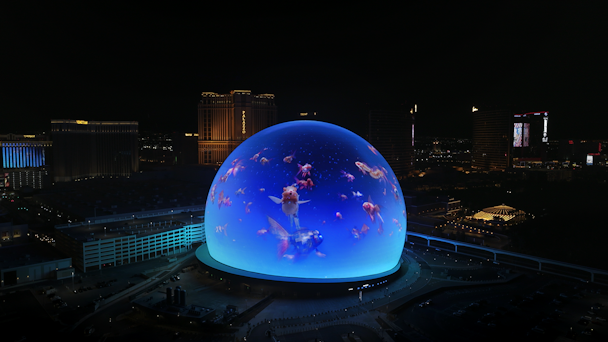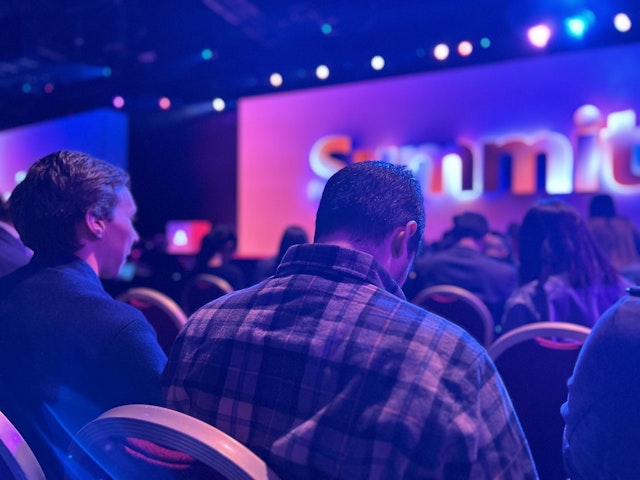Adobe’s ambitions for Firefly underline how AI will disrupt the agency business
The creative software company claims it isn’t gearing up to compete with creative agencies, even though its AI suite occupies some of the same ground as WPP and Publicis proposals and targets a similar clientele.

IBM's 'Trust What You Create' campaign showing on the Las Vegas Sphere / IBM
At the Venetian Resort in Las Vegas, you don’t ever really need to go outside. The hotel-casino is a 3,000-suite maze in marble and gold leaf containing bars, cafés, shops and its own Grand Canal replete with gondoliers and a painted ceiling providing perpetual twilight – though, thanks to the light of the nearby Sphere, it feels like nowhere in the city really experiences nighttime.
Walking across the casino floor to grab breakfast before the annual Adobe Summit, I spot a guest playing Ultimate Texas Hold ‘Em – a faster variant of the game in which players face only the dealer. This time, they beat the house.
Adobe has hosted several editions of this conference here. Previously, it was a sales convention aimed at ginning up demand among enterprise clients – but since the company used it to announce the launch of generative AI tool Firefly at last spring’s event, it’s become a de facto stop on the AI hype circuit. This year, the tech firm’s execs used the stage to expand their suite of products well beyond production tools. Marketers struggling with budget and time pressures might not ever need to leave the Adobe ecosystem again.

On stage, the firm’s leaders hosted new software demos, toasted the takeup of Firefly (users have input 6.5bn prompts since launch, according to chief executive Shantanu Narayen) and held softball Q&A sessions with top marketers and Adobe customers, including General Motors boss Mary Barra. At the close of her keynote, the automobile exec was tasked with a word association quiz including prompts such as ‘Chevrolet,’ ‘Detroit’ and her own name. To the latter, she ventured: “Down to earth.”
The company’s latest range of products is anchored around Firefly and its enterprise planning and workflow software, GenStudio. The former is rapidly becoming the tool marketers and agencies feel most comfortable putting into service. In a few months, Anil Chakravarthy, president of Adobe’s digital experience business, told convention-goers the company will add the ability to generate video, 3D imagery and audio media using Firefly.
Advertisement
Firefly Services, a suite of APIs and other tools, is intended to let marketers funnel more of their production work through Firefly itself, while its Custom Models will allow brands to train their own AI training models using their own intellectual property. These developments, according to Chakravarthy, are designed “to help you realize the promise of personalization at scale by delivering the right creative content to the right audience at exactly the right time.”
“It’s built for marketers to be able to self-serve,” says Don Bennion, senior director of product marketing for Adobe GenStudio. He says the platform’s ideal user is the “practitioner-marketer,” brand-side staffers looking to create large amounts of social and performance media assets while also cutting costs. “Demand for content is increasing; budgets are staying somewhat flat. Something has to give and a lot of folks are turning to generative AI,” he explains.
In particular, Adobe is gunning for marketers at America’s largest brand names, companies that agencies fight tooth and nail to get into the pitch room with. “We’re targeting enterprise… as big as it gets. Coca-Cola? Absolutely,” he says. “From the mid-market up, that’s what we’re looking at. We’re not currently targeting SMEs.”
As such, it’s companies with large in-house marketing teams that provide the clearest guess as to what an Adobe-first marketing approach looks like. IBM, which is developing several of its own generative AI tools and is arguably an even larger player in the AI space than Adobe, used Firefly in the production of its latest brand campaign, ‘Trust What You Create.’
Advertisement
During the convention, the brand took over the Las Vegas Sphere to display a fishbowl of aquatic creatures altered by AI errors. The spot showed them being cleansed by the power of its own AI tool, WatsonX. Billy Seabrook, global chief design officer at IBM Consulting, says the company expects to save $100m in production costs using Firefly over the next three years.
“Our use of it is in the upfront ideation process,” he says. “We’re accelerating and creating more inspiration, visualizing ideas and core concepts at scale.”
Though it continues to experiment with competing software such as Midjourney or Dall-E, Seabrook says that Firefly is the only image-generating tool the tech giant has cleared for commercial use.

In large part, that comes down to a promise of security Adobe has been able to grant to its customers. Firefly is trained on Adobe Stock or on media that has fallen out of copyright, meaning assets generated using the tool shouldn’t violate current copyright law. The company behind Midjourney, by contrast, is accused in several lawsuits of pulling media from the open web to train its software. Both IBM and Adobe have also provided automatic indemnification to enterprise clients – in plain English, offering to pay their costs should a legal complaint arise.
“Effectively, it’s a whole new business model. It’s an insurance policy,” says Seabrook.
Alongside the product demos and case studies on display at Summit, Adobe has been working to further befriend the power brokers of advertising. Interpublic Group (IPG) inked a deal to use Adobe GenStudio, among other software, in its AI-derived Engine service back in February. WPP has joined its Content Authenticity Initiative, a push to include metadata on images and videos created using its tools. The project enables altered works to be identified and tagged and will likely put the firm on the front foot should a regulatory backlash to generative AI emerge.
Suggested newsletters for you
Meanwhile, Accenture Song announced a fresh strategic alliance with the tech company at the convention. This time, it’s been drafted in to build Firefly use cases tailored to specific client sectors, starting with retail, consumer goods, automotive, financial services and healthcare clients. Though forgoing a stall on the convention floor, its logo could be seen adorning a DJ booth in the lobby.
The consultancy is set to integrate Adobe’s custom training models into the services it provides clients, says global ecosystem lead Bob Markham. The idea, he explains, is to provide marketers with pre-designed templates, the better to speed up production time. “Brands today want to move beyond experimenting with generative AI to achieve real impact. But they need support to integrate the technology with their data and broader systems,” he says. ”Being able to use Adobe to customize a set of images so that any single one of our 742,000 people could post a social media post or client introduction is the real business value. I think most clients are in a similar place.”
On the vast, brightly lit convention floor, WPP, Merkle and Publicis Sapient reps fought martech vendors for the focus of attendees; some of their stalls included banners touting their teams’ expertise with Adobe’s kit. Amid an ongoing campaign to increase its US client base and diversify from its Netherlands roots, private equity-backed agency group Dept had also pitched up with an austere, black-and-white stall that stuck out amid the neon and marble of Vegas. Attendees bored by sales pitches could try their hand at an arcade claw machine (also in stark black livery), which the agency’s staff had rented for the occasion and filled with candy. With the coin operation suspended, every grab made granted players a free attempt – making it the game with the best odds in the city.
Adobe is eager to promote the idea that its AI tools are fit for commercial use now – not in six months. In one session, senior director Jason Knell held a joint presentation with Meta director Jonathan Kratz, emphasizing the compatibility of Adobe’s production tools with Facebook’s Advantage+ product, a new type of ad inventory it unveiled last year that uses AI to parse data and target audiences. By Meta’s reckoning, the format has provided advertisers with a 32% higher return on investment (ROI). An extension in Adobe’s commerce cloud connects Adobe’s commerce products with marketers’ Meta accounts. Paired with a potentially huge inventory of creative assets, Knell said the combination meant that “we empower you to power any kind of business model from one single platform. It’s basically data in, data out.”
“I think that’s beautifully said,” added Kratz.
Ad agencies and the tech companies that have remolded the advertising industry in their own image over the last 20 years were once described as “frenemies” by Sir Martin Sorrell. The careful distance they’ve kept from one another’s core businesses might soon become very short.
The advertising sector’s largest agency players, WPP and Publicis Groupe, have both signaled major investments in generative AI capabilities and outlined service offerings that, in theory, provide marketers with everything they need to take advantage of the economics of AI. WPP hopes that licensing bespoke training models (called ‘Brains’), using generative AI tools in production, and AI-enabled strategy work will set it apart. Meanwhile, rival Publicis is developing ‘CoreAI,’ a single platform combining AI technology and its owned consumer data. The technology has also begun to motivate internal restructures at the holding companies, such as the merger of performance media shop mSix and creative agency The&Partnership announced in March.

Bennion says Adobe isn’t gearing up to compete with agencies. “We’re both serving the marketer,” he adds. But the competing WPP and Publicis proposals occupy some of the same ground as Adobe’s enterprise AI suite, while sharing a similar target clientele. A CPG brand with a large enough in-house agency could, for example, seriously consider using GenStudio instead of a holding company’s production shop for social media campaign assets.
Furthermore, brand marketers are going to face direct choices between companies such as Adobe and their agency partners regarding the training models generative AI tools draw from. Are they going to rely upon an off-the-shelf training model, such as the one behind Firefly, or a bespoke one provided for them by their agency? Will they choose to own that model outright – which Adobe’s Custom Models would allow – or license it from an agency network?
Off the convention floor, Wesley ter Haar, one of the co-founders of Media.Monks, asks jokingly if I’m there to write about the “sad death of the agency.”
Ter Haar is the company’s self-described “AI guy” and one of the architects behind its push to incorporate the tech; Media.Monks was the first agency to come to market with an AI offering last year, just three months after the launch of ChatGPT.
He tells The Drum that he expects generative AI’s democratic impact to seriously challenge agency players. The sheer fact that someone without training can create an image that can run as a campaign asset without the services of an illustrator or designer is a real threat.
“I think this is going to help a lot of smaller businesses help themselves,” he says. “And the agencies that service those are going to get the first big hit because [their clients] are just going to hire one or two people to run little internal organizations and do most of their own design.”
Companies operating beneath the level of major advertisers, he suggests, will soon find in-housing options much more feasible. “I think you’ll see a lot of disruption there.”
Media.Monks’s strategy sidesteps the training model issue, instead focusing on providing “software and a service.” Rather than build models and charge brands for access, it will work with training models that marketing organizations themselves own. It has already begun using a radically different pricing structure that incorporates the “value” unlocked by AI-led production.
“Our belief is big brands should own their own models. They should own their own datasets. That’s your competitive advantage in a landscape where everything speeds up, everything scales up. Your own model and the ability to have that model fight for you is important,” says Ter Haar. “I think people underestimate what’s about to happen.”
To demonstrate the potential of Firefly, Adobe’s senior design director, Ann Rich, took to the stage. In a few minutes, she conjured up an entire library of design assets for a Facebook campaign from a handful of initial Coca-Cola product shots. The soda maker – for which WPP built an entirely bespoke agency unit dubbed OpenX – has been using Adobe’s custom models for months already. Synchronization with a Meta account, she noted, would allow a marketer to track audience engagement with each individual asset.
“This,” said Rich, “is a complete marketing experience.”

